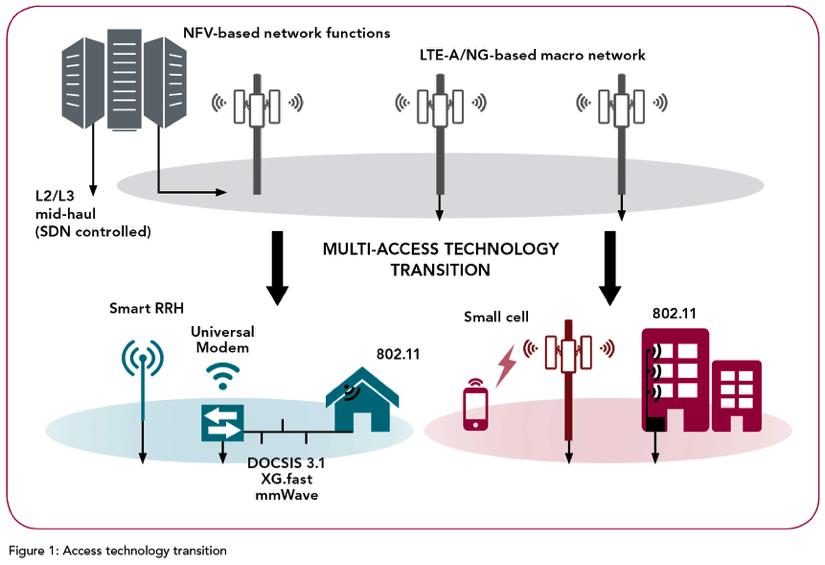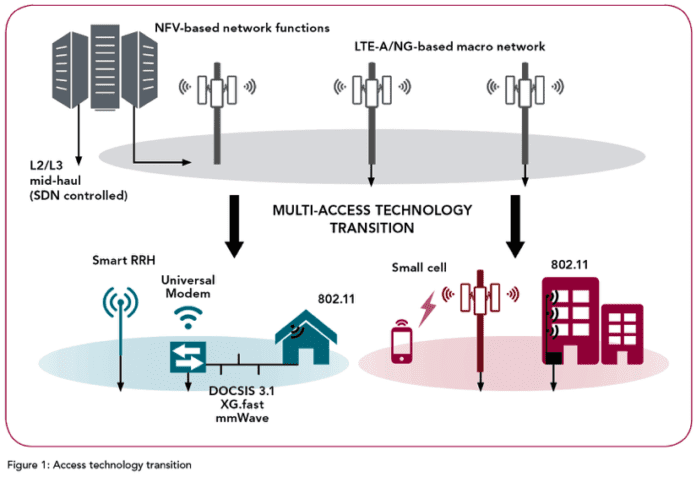Over the last decade, we have experienced rapid growth of broadband access to both consumers and businesses. This growth of broadband services is being driven by multiple factors, namely:
1. The fast deployment of public and private Cloud systems increasing number of over-the-top (OTT) service providers and content being made available to consumers
2. The growth of the IoT and associated big data and analytics
3. In turn, all of these factors drive an increase in high bandwidth technologies being deployed to businesses and consumers to achieve ubiquitous coverage.
The deployment of access technologies also requires that service providers achieve continuous CAPEX and OPEX efficiencies, while simultaneously supporting the co-existence of different generations of access technologies deployed in the market.
While enterprise and service-provider communications have been stuck in the rip-and-replace model of periodic network upgrades, a funny thing has happened in the quest for ever faster speeds. Networks’ physical layers have converged on OFDM and wide channel bands, regardless of media (wired or wireless), band (baseband, sub-6GHz, or millimeter wave), and standards body (ITU or IEEE). In many cases, these various network technologies will simultaneously offer the same user network access. For example, the user may be served by G.Fast broadband via Wi-Fi, sub-6GHz LTE, and mmWave-based 5G cellular.
But not every aspect of networks has converged and none will be forever static. OFDM parameters, such as subcarrier spacing, vary as much as a result of the different paths committees take toward standardization as for technical reasons. Massive MIMO makes sense for 28GHz and higher carrier frequencies owing to their small antennas and poor signal propagation. At Layer 2, networks differ significantly because of differing topologies and usage models. Meanwhile, vendors continually upgrade their designs, and the industry periodically updates its standards. Network systems must either rely on unique hardware for each standard as they have in the past or hardware with revolutionary flexibility.
What is required Is a new approach, combining hardware and software architectures to enable a solution which leverages networking and wireless domain expertise to solve the challenges of multi-generation support efficiently while delivering a scalable solution for multiple segments.
Observing the trend toward technology convergence and the benefits flexibility (if it can be provided without compromise to performance or efficiency), NXP developed a unifying, programmable architecture.
The advent of 5G necessitates a breakthrough of the limits imposed by hardwired solutions, freeing enterprises and service providers to reap the benefits of software-defined access. Such an architecture could transform the business model of communication services, be they deployed by enterprises for internal customers or by telecommunications companies for external customers.
Historically, solutions in the market have had most of their key modem technologies implemented in hardwired logic functions due to power, performance and cost. However, they have offered limited programmable options for addressing standards or overall requirements.
An Intriguing single hardware/software modem architecture could support multiple modem implementations through firmware loads.
Key components of the architecture would include:
1. PHY: Single physical layer architecture and implementation across converging wireless and wired standards, providing programmability and flexibility without sacrificing efficiency
2. MAC: Tight integration with an optimized packet processing engine that is scalable to support the required multi-Gbps MAC layer throughput
3. Packet processing (networking) engine: Seamless integration with networking and control IP designed to support complex packet routing applications, network services, as well as support for remote provisioning and virtualized networks
4. SoC: Integrated solution leveraging the key technologies—programmable PHY and MAC, packet engines, ARM® 64b Cores and associated memory, interconnect and high-speed I/O
5. Development: An ever-growing software development ecosystem that OEMs and operators can use to speed their time-to-market with differentiated solutions; initial application areas targeted include 802.11/Wi-Fi (2.4/5 and 60 GHz) and 3GPP (5G) wireless access technologies.
Converging access technologies
The number of connected devices is growing at an exponential rate. The Internet of Things (IoT) is driving the need for secure network connectivity for a wide range of use cases and systems. People, machines, processes and information are all demanding network connections with different performance requirements and consistent, reliable connectivity. We see a rapid growth of various connectivity technologies happening in parallel with a strong demand for well-managed and cost-effective solutions leveraging those technologies.
The continued development from 1G through GSM, WCDMA and LTE/5G wireless access techniques has driven continued evolution from the channel access method, moving from analog through FDMA/TDMA (2G), CDMA (3G) and OFDM(A) (4G/5G). Similarly, other wireless standards (802.11, Digital Audio/Video Broadcasting (DAB/DVB) also use OFDM. This evolution has allowed modern wireless communication systems to be near the Shannon limit of channel efficiency. Also, wired access (Digital Subscriber Line or xDSL) uses OFDM/subchannel based channel access, using similar signal processing techniques as those used in wireless communications.
Similar convergence trends can be observed in the width of the access channel across access methods. LTE-A and 5G channels, Wi-Fi (for example, 802.11ax) and DSL (G.fast) all operate in 100-200 MHz wide channels. Combining this with the trend to reduce the distance between the access point and the user to Today, the technologies summarized above are being deployed in various use cases and systems. In many cases, user access will be provided by multiple access technologies simultaneously, where each technology is optimized toward a single aspect of the user experience. Examples include Wi-Fi access for in-house high bandwidth, sub-6GHz small cell and macro LTE for outdoor coverage and mmWave system for hot-spots to name a few.
While the listed technologies do exhibit some common access channel methods, a wide range of implementations have existed because of a lack of unifying technology, until now.
 .
.
To illustrate the benefits of a converged architecture approach, let’s review a use case with an enterprise access point deployment. In this scenario, assume a company is adding a 60GHz radio module to an existing Wi-Fi access point to meet bandwidth demand for new wireless use cases. Assume an 802.11ad module costs $150 and installation costs another $50. The addition on its own is not a huge expense, but a new 60GHz Wi-Fi standard, 802.11ay, is on the cusp of being standardized. With a radio based on Layerscape access solutions, the company can address its use cases now and upgrade to 802.11ay at little cost via software in the future.
A bigger benefit to a software-defined radio in the 60GHz band is that real-world performance is likely to arise as a problem. The enterprise could spend hours of troubleshooting (assume 5 hours at $200 per hour for a consultant) and perhaps scrap the 60GHz Wi-Fi deployment owing to poor network performance. However, as 60GHz Wi-Fi vendors gain field experience with the phased antenna arrays and associated signal processing, they will upgrade their algorithms.
A fully programmable physical layer, including antenna processing, will help enable vendors to implement these upgrades on existing customer hardware. Thus, the enterprise’s initial expense of $200 per node is its final expense and not a precursor to expenses several times greater for upgrades and debugging.
Fully programmable physical-layer hardware could completely transform the industry. Communications gear has historically been deployed in a rip-and-replace cycle. To deploy new services or technologies, businesses and service providers replaced old equipment with new equipment. From a technology perspective, this yielded a stair-step experience: a step up in CapEx for installing new gear followed by a plateau of no CapEx during which users experienced the upgraded network.
Equipment based on converged access technology can help smooth this experience: users get new network services or better performance more often, equipment hardware lifecycles are longer, and network upgrades are more frequent and less expensive because they are based on software. Mirroring this shift from hardware to software is a shift in cash flow from large capital investment lumps depreciated over several years to smaller annual operational expenses for new software, acquired as needed to increment the network’s capabilities. In short, the network has become more consumable.
A fully-programmable solution provides a path to addressing the market needs and challenges identified at the beginning of this paper—namely providing the capability to meet the needs of bandwidth-hungry users and applications while still providing for backward compatibility for existing user devices and network systems. The announced solution and system enables an efficient and programmable solution to provide for flexibility and deployment ease.

